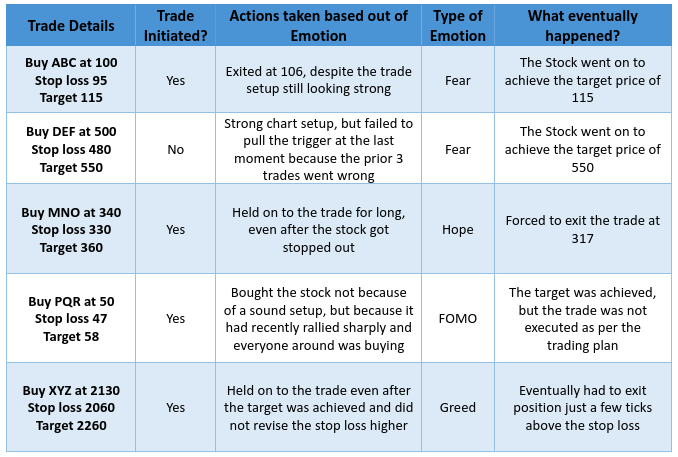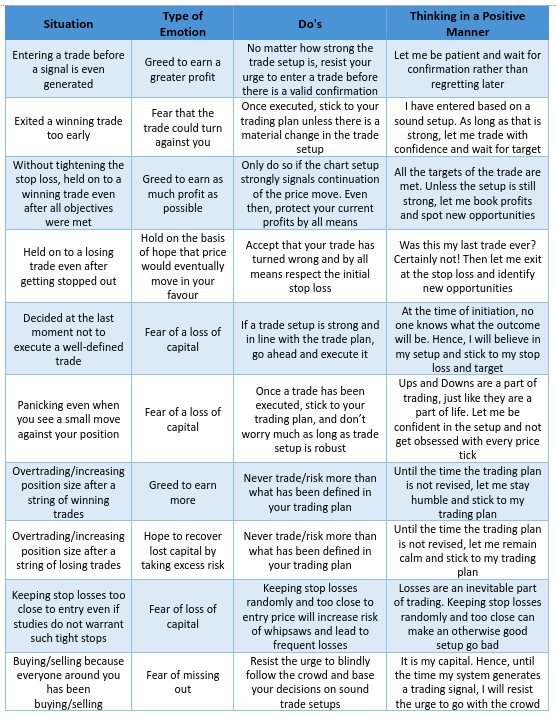
Now that we know the various emotions and biases that traders are exposed to when trading, it is time to talk about various measures that one could take to keep emotions and biases under control. A lot of this has to do with controlling your mind and keeping a track of your emotions, and this is what we will talk about over the course of this chapter as well as in the next.
By now, we know that trading psychology is the human mindset that is in play before, during, and after a trade. It represents the emotions and inherent biases that influence trading decisions. Even if a trade is based on a sound setup, emotions and biases are something that one needs to deal with. If not, they can hamper the success of trades. For instance, let us say a swing trader bought a stock based on a sound technical setup that included a breakout from a bullish H&S pattern along with a notable expansion in volume (to know what this pattern, click here). However, the trade failed, and the trader had to exit at a loss. The trader was notably disappointed. Soon after, he spotted a similar setup in another stock. In fact, the signal this time was even stronger than the previous. However, as the prior trade based on the same setup had failed, the trader refrained from taking position this time. Notice here how a past event affected the decision-making ability of the trader, despite the setup looking promising. If this trade works out well, the trader could be even more disappointed as to why he did not initiate the trade. This in turn might prompt him to take the next trade based out of emotion. So, as you can see, a vicious cycle could unfold if emotions and biases are not dealt with.
So, how does one deal with emotions and biases? Well, we already spoke about biases and how to deal with them in the prior two chapters. As you are now aware of some of the key trading biases and how these can be dealt with, the first thing that you need to do is identify and take a note of the biases you face, some of which you might be facing unknowingly. Only once the biases are identified can appropriate steps be taken to keep errors under control and improve your trading success.
A positive mental attitude:
If you are getting started into trading or do not have much experience in trading, emotions are something that you will have to start dealing with right from the start, so as to keep trading mistakes under check. Keep in mind that knowledge and experience are not the only factors that separate success from failure. Dealing with emotions and biases are also as important, if not more. One way to deal with emotions is to have a positive mental attitude before, during, as well as after a trade. Doing so will help keep emotions, such as fear and stress, under check. However, this is achievable only when you have in place a proper trading plan with appropriate risk and money management strategies. Without these, no matter how hard you try, it would be difficult to trade with a positive mindset. It’s akin to driving a car without knowing the destination to go.
So, right from the start, you need to have a proper trading plan. You need to define things that you religiously follow when trading, such as:
- The maximum you are willing to risk per trade
- Appropriate position sizing depending on your risk tolerance
- Maximum number of trades that would be running parallel at any point in time
- The stop loss for each trade
- The reward to risk for each trade
- Maximum capital drawdown from a certain threshold, before taking a break and making amendments, if necessary
- Keeping a record of all the trades and being aware of the historical statistics, etc.
Once a proper plan is in place, trading becomes much more peaceful. This can in turn help a trader to keep emotions under check. All that the trader then needs to do is ensure that he or she sticks to the plan and stays disciplined. Let us understand this using an example. Let us that there are two traders: Ron and Paul. Ron has a proper plan in place, while Paul has no plan in place and no statistics to keep a track of. Let us say that out of the last 100 trades Ron made, 70 were profitable. However, as Paul is not keeping a record of his trades, he is aware of his historical performance. Let us now assume that over the next three trades that each of Ron and Paul executed, all were exited at a loss. Ron is not worried about this minor blip as he is disciplined, diligently follows his trading system, and is aware of his historical performance, which has been good. On the other hand, Paul is worried and stressed out because he does not remember his long-term performance and can only recollect a handful of his last few trades, which have been disappointing. So, when a proper plan is in place, a significant mental hurdle to trading gets automatically removed, which in turn helps one to trade with a positive mindset.
Learning to live with emotions:
Emotions can be reduced but not entirely eliminated. After all, we are humans and emotions are an integral part of our lives. Because emotions cannot be eliminated, it is important to learn how to live with them and simultaneously manage trades rationally. Even successful traders face emotions when their trades are not working out as expected – it is quite natural to do so. However, what separates them from the rest is that they know how to manage their emotions and ensure that these do not impair their decisions or cause them to act irrationally. Again, if you are disciplined, you can manage your emotions and take decisions rationally, even when you are in a losing position. Thinking positively is one way in which you can learn to live with emotions. Let us now explain how using some examples:
- Remind yourself that the current trade is not your last trade: A trader entered a long position in a stock. Let us assume that the trade is turning out to be bad and the price is just a few ticks away from hitting the stop loss. As the stop loss approaches, the emotion of hope could kick in and cause the trader to ignore the stop loss and hold on to the losing position or average out the losses. One way of dealing with this emotion and ensuring that it does not affect your decision-making ability is to think in a positive manner. Is this trade my last ever trade? Definitely not! I would be taking many more trades going forward. So, rather than getting stuck in a bad trade and letting it affect your mind, why not accept a loss, learn from it, and move on to spot new trading opportunities? Thinking this way will help you manage your emotions much better.
- Embrace the fact that trading is about probabilities and not certainties and that losses will be a part of life: A trader identifies a trade opportunity in a stock. He has a strong conviction on the trade setup but decides not to pull the entry trigger at the last moment, due to fear that the trade could go wrong. This is a very common fear that even experienced traders face sometimes. When this fear takes over, the trader could refrain from taking trades, cut short his/her winning trades, and hold on to losing trades for long. So how could one deal with this? Well, always keep in mind the fact that trading is all about probabilities and not certainties. When entering, there is a possibility that the trade might fail, just as there is a possibility that it might work well. Even trader goes through this when trading, be it a beginner or a veteran. Hence, embrace the fact that some of your trades will go wrong and there is no way this can be avoided.
- Embrace the fact that it is not possible to capture the entire price move: A trader made a decent profit in the previous trade and exited the trade once the price target was achieved. However, post exiting the trade, the trader was gutted to see the price move continuing and wished that he/she had held on to the position. Goes without saying, the emotion of greed could influence the trader’s decision in subsequent trades. It could cause him/her to hold on to positions beyond a reasonable time and take risks beyond those defined in the original trade and trading plan. How can one deal with such emotions? Well, keep in mind that no one can capture the entire price rally or decline from start to finish. It may sometimes happen, but do not get obsessed with it. Always remind yourself to stick to your trading plan rather than deviate from it and weigh the current trade setup logically.
Many such examples can be spoken about, but you get the point. Remember, emotions are a part of life and a part of trading as well. They cannot be avoided altogether. Instead, you must learn to live with them and manage them efficiently.
Maintaining a journal of your emotions:
As you get along your trading journey and gain experience, you would understand how to deal with emotions and control them, provided you are aware of them and are learning from them. However, there will be times when some of your decisions would still be driven by emotions. So, how does one deal with this? Well, one way is to maintain a journal of emotions. Whenever you let your trading decision be based out of emotion, irrespective of whether it was a failure or a success, make a note of that decision. In the journal, write down the details of the trade and the reason(s) that caused you to act emotionally. Even include those trades that you were about to initiate but your emotions prevented you from pulling the trigger. Write down these details immediately after you take the decision, so that you can mention all the factors that prompted you to act emotionally. If you delay too much, there is a possibility you might forget the factors that led you to act in a particular manner.
The advantage of maintaining such a journal is that over a period of time, you can analyse all the factors that prompted you to act emotionally. If a few of these are repetitive in nature, not only will you become aware of the emotions affecting you, but you can then take corrective steps to keep those emotions under check. For instance, let us say that you recently started to maintain a log of your emotions. Of the past 10 trades that were based out of emotions, you notice that 5 were based on entering a trade too soon and 3 were based on booking profits too soon despite the setup still looking robust. See that you are now not only aware of the emotions that you are falling prey to but can also use this information to take corrective steps so as to prevent such emotions from influencing your future trading decisions. Maintaining a journal of your emotions can go a long way in helping you to deal with your emotions. Shown below is one sample journal of trades based on emotions.

Making a checklist of emotions and listing how to deal with them:
Yet another way of managing emotions is to make a checklist of various emotions that you feel you could encounter when trading. Then, for each emotion, you would also list down the step(s) you could take to refrain it from impacting your trading decision. Again, having a positive mindset is very helpful. Of course, this list won’t be an exhaustive list. However, you could keep this list at your trading desk and add new emotions as and when you encounter them when trading. This way, you will not only understand the various emotions you face or are likely to face but also know the right steps to take when such emotions get over your mind. Shown below is one such sample of checklist along with the Do’s and how to think in a positive manner.

In the next chapter, we will continue our discussion on dealing with emotions.
Next Chapter
Comments & Discussions in
FYERS Community